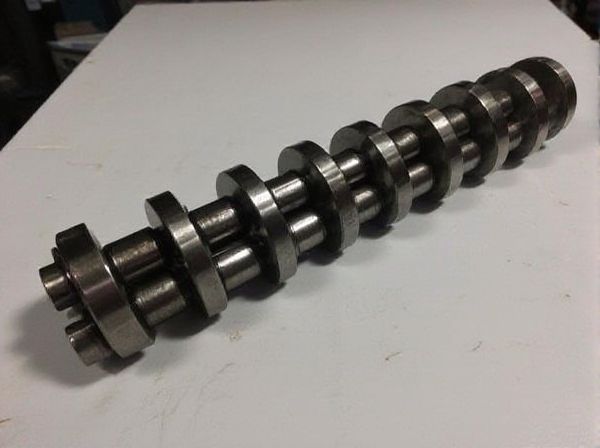
Photo illustration: Non-Hardened Camshaft vs Case-Hardened Camshaft
Non-hardened camshafts offer greater flexibility and ease of machining but may wear out faster under high-stress conditions. Case-hardened camshafts feature a tough outer layer that improves durability and resistance to surface wear while maintaining a softer, shock-absorbing core. Your choice depends on the specific performance requirements and longevity needed for the engine application.
Table of Comparison
| Feature | Non-Hardened Camshaft | Case-Hardened Camshaft |
|---|---|---|
| Material Hardness | Soft, uniform hardness | Hard outer layer, soft core |
| Wear Resistance | Lower resistance, prone to wear | High resistance, enhanced durability |
| Application | Standard engines, low-load conditions | High-performance engines, heavy load |
| Manufacturing Process | Simple machining | Heat treatment, carburizing |
| Cost | Lower production cost | Higher production cost |
| Durability | Moderate lifespan | Extended lifespan |
Introduction to Camshaft Materials
Non-hardened camshafts are typically made from cast iron or billet steel, offering a balance of strength and machinability but with limited surface wear resistance. Case-hardened camshafts undergo a heat treatment process that hardens the outer layer while maintaining a tough core, significantly improving durability and resistance to surface fatigue. Choosing between these materials depends on engine performance requirements, where case hardening enhances longevity in high-stress applications.
Understanding Non-Hardened Camshafts
Non-hardened camshafts are crafted from materials like cast iron or billet steel without undergoing surface hardening processes, resulting in a uniform material density throughout the component. These camshafts exhibit less resistance to wear and stress compared to case-hardened camshafts, making them suitable for applications with lower performance demands or where cost efficiency is prioritized. Understanding the material properties and wear characteristics of non-hardened camshafts is critical for selecting the appropriate camshaft type in engine rebuilding and tuning scenarios.
What Is a Case-Hardened Camshaft?
A case-hardened camshaft undergoes a heat treatment process that hardens only the outer surface while maintaining a softer, tougher core, enhancing wear resistance and durability. This surface layer, typically formed through carburizing or nitriding, improves the camshaft's ability to withstand high friction and stress in engine operation. Compared to non-hardened camshafts, case-hardened variants offer superior longevity and performance in demanding automotive applications.
Key Differences Between Non-Hardened and Case-Hardened Camshafts
Non-hardened camshafts are typically made from softer materials or cast iron, offering lower resistance to wear and fatigue compared to case-hardened camshafts, which undergo a heat treatment process to create a hardened surface layer. Case-hardened camshafts feature improved durability, enhanced wear resistance, and better performance in high-stress engine environments, making them ideal for aggressive or high-performance applications. The key differences lie in surface hardness, longevity, and suitability for demanding operating conditions, with case-hardened camshafts providing superior strength and reduced risk of deformation or failure under heavy load.
Performance Impacts of Camshaft Hardening
Non-hardened camshafts typically offer lower durability due to their softer surface, leading to accelerated wear under high-stress conditions and reduced overall engine performance over time. Case-hardened camshafts feature a hardened surface layer that enhances resistance to wear, improving longevity and maintaining optimal valve timing and lift for consistent engine power. The hardened layer provides a balance between toughness and fatigue resistance, crucial for high-performance applications demanding sustained mechanical precision and reliability.
Durability and Longevity Comparison
Non-hardened camshafts typically exhibit lower wear resistance due to the absence of surface treatment, leading to reduced durability and shorter operational lifespan under high stress conditions. Case-hardened camshafts undergo a heat treatment process that creates a hard, wear-resistant surface layer while maintaining a tough core, significantly enhancing resistance to friction and fatigue. This results in superior longevity and consistent performance, making case-hardened camshafts ideal for high-performance and heavy-duty engines.
Manufacturing Processes Involved
Non-hardened camshafts are typically manufactured using processes such as forging or casting followed by precision machining, without additional surface treatment, resulting in a component suitable for low-stress applications. Case-hardened camshafts undergo a heat treatment process, such as carburizing or nitriding, where the surface is enriched with carbon or nitrogen to create a hard, wear-resistant outer layer while maintaining a ductile core, enhancing durability under high-stress conditions. This manufacturing distinction affects performance, with case-hardened camshafts being preferred in engines requiring greater resistance to wear and fatigue.
Cost Considerations and Value
Non-hardened camshafts typically offer lower upfront costs due to simpler manufacturing processes but may require more frequent replacements or maintenance, impacting long-term expenses. Case-hardened camshafts, despite higher initial investment, provide superior surface durability and wear resistance, resulting in extended service life and reduced downtime costs. Evaluating cost considerations involves balancing initial purchase price against longevity and performance value to determine the most economical option for specific engine applications.
Applications in Automotive and Industry
Non-hardened camshafts are typically found in low-stress automotive engines and small machinery where moderate wear resistance is sufficient, offering cost-effective performance with easier machinability. Case-hardened camshafts are essential in high-performance automotive engines and heavy industrial equipment, providing a hard, wear-resistant surface while maintaining a tough and ductile core to withstand significant mechanical stresses. This balance in case-hardening extends camshaft lifespan and enhances reliability under demanding conditions such as racing engines and large-scale manufacturing machinery.
Choosing the Right Camshaft for Your Engine
Choosing the right camshaft for your engine depends on factors such as durability, performance requirements, and budget. Non-hardened camshafts offer cost-effective solutions with adequate wear resistance for mild performance engines, while case-hardened camshafts provide superior surface hardness and increased longevity ideal for high-performance or heavy-duty applications. Evaluating engine load, intended use, and maintenance expectations ensures optimal camshaft selection to maximize engine efficiency and lifespan.
 caratoz.com
caratoz.com